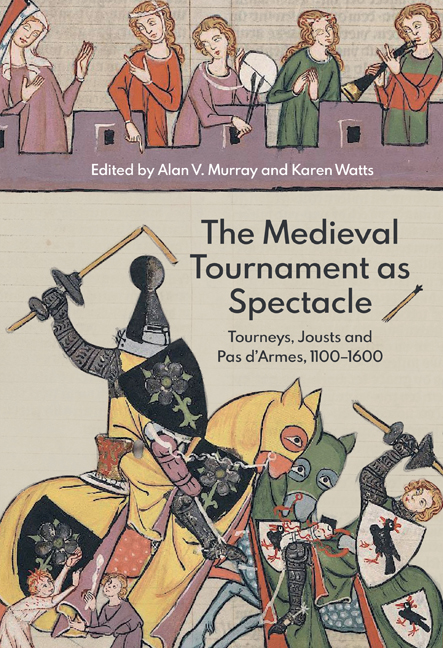Book contents
- Frontmatter
- Contents
- List of Illustrations
- List of Contributors
- Preface and Acknowledgements
- Introduction: From Mass Combat to Field of Cloth of Gold
- Research on the Medieval Tournament (1100–1600): A Select Bibliography
- 1 Now Form Up Close Together! Tactics and Ethos of the Tourney in Early German Sources (Twelfth to Thirteenth Centuries)
- 2 Por pris et por enor: Ideas of Honour as Reflected in the Medieval Tournament
- 3 Richard II of England and the Smithfield Tournament of October 1390: An Instrument to Establish Royal Authority
- 4 Alle myn harneys for the justes: Documents as a Source for Medieval Jousting Armour
- 5 The Tournament Saddle
- 6 Between Sport and Theatre: How Spectacular was the Pas d’armes?
- 7 Art Imitating Life Imitating Art? Representations of the Pas d’armes in Burgundian Prose Romance: The Case of Jehan d’Avennes
- 8 The Foot Combat as Tournament Event: Equipment, Space and Forms
- 9 Power and Pageantry: The Tournament at the Court of Maximilian I
- 10 The Field of Cloth of Gold: Arms, Armour and the Sporting Prowess of King Henry VIII and King Francis I
- Appendix 1 Calendar of the Royal Combats at the Field of Cloth of Gold, June 1520
- Appendix 2 Articles for the Challenge: The Emprise
- Index of Objects
- Index of Manuscripts
- General Index
7 - Art Imitating Life Imitating Art? Representations of the Pas d’armes in Burgundian Prose Romance: The Case of Jehan d’Avennes
Published online by Cambridge University Press: 11 September 2020
- Frontmatter
- Contents
- List of Illustrations
- List of Contributors
- Preface and Acknowledgements
- Introduction: From Mass Combat to Field of Cloth of Gold
- Research on the Medieval Tournament (1100–1600): A Select Bibliography
- 1 Now Form Up Close Together! Tactics and Ethos of the Tourney in Early German Sources (Twelfth to Thirteenth Centuries)
- 2 Por pris et por enor: Ideas of Honour as Reflected in the Medieval Tournament
- 3 Richard II of England and the Smithfield Tournament of October 1390: An Instrument to Establish Royal Authority
- 4 Alle myn harneys for the justes: Documents as a Source for Medieval Jousting Armour
- 5 The Tournament Saddle
- 6 Between Sport and Theatre: How Spectacular was the Pas d’armes?
- 7 Art Imitating Life Imitating Art? Representations of the Pas d’armes in Burgundian Prose Romance: The Case of Jehan d’Avennes
- 8 The Foot Combat as Tournament Event: Equipment, Space and Forms
- 9 Power and Pageantry: The Tournament at the Court of Maximilian I
- 10 The Field of Cloth of Gold: Arms, Armour and the Sporting Prowess of King Henry VIII and King Francis I
- Appendix 1 Calendar of the Royal Combats at the Field of Cloth of Gold, June 1520
- Appendix 2 Articles for the Challenge: The Emprise
- Index of Objects
- Index of Manuscripts
- General Index
Summary
Scholarship on the pas d’armes over the last thirty years or so has definitively laid to rest the idea that this type of literary-inspired tournament is in any way symptomatic of the decadence or infantilism of the chivalric culture of the late Middle Ages, as earlier commentators such as Johan Huizinga once claimed. Thus, for example, Michel Stanesco has attributed the popularity of the pas d’armes in fifteenth-century Anjou and Burgundy to a genuine desire on the part of the late medieval nobility to emulate their literary avatars, a process he dubs the enromancement (‘romanticisation’) of daily life. Jean-Pierre Jourdan, for his part, has shown how these spectacles of elite sporting prowess were integral to the political life of the period, being organised as part of larger occasions such as marriages, peace treaties and ceremonial entries at which the nobility conducted its essential business and affirmed its identity as an exclusive social group. Furthermore, as Christiane Raynaud observes, being timed to coincide with key dates in the liturgical calendar, these events could also be an encouragement to undertake crusade, the very highest application of chivalric prowess for serious military and spiritual ends, as in the case of the famous Pas de la Fontaine des Pleurs of 1449–50 that was organised by the Burgundian knight Jacques de Lalaing during the year of the jubilee in Rome.
As the ultimate late medieval example of life imitating art, the pas d’armes are based on often elaborate literary scenarios, with the idea of amorous service to a mysterious Lady acting as a pretext for the tournament itself. While some pas are inspired by fairly generic romance motifs such as combat by a ford or a bridge against foes such as shepherds or wild men, others draw on specific literary texts, though not always with great fidelity to the original source.
- Type
- Chapter
- Information
- The Medieval Tournament as SpectacleTourneys, Jousts and Pas d'Armes, 1100-1600, pp. 139 - 154Publisher: Boydell & BrewerPrint publication year: 2020

